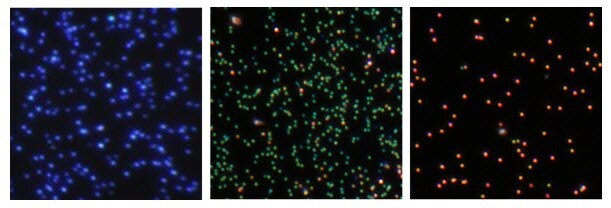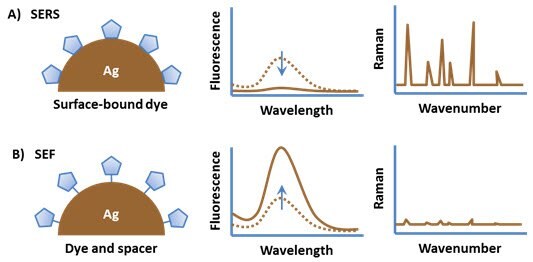Silver Nanomaterials: Properties & Applications
Steven J. Oldenburg, Ph. D., President,
nanoComposix, Inc. San Diego, California 92111
Introduction
Silver nanomaterials have unique physical, chemical and optical properties that are being leveraged for a wide variety of applications. A resurgence of interest in the utility of silver as a broad based antimicrobial agent has led to the development of hundreds of products that incorporate silver nanoparticles to prevent bacterial growth on surfaces and in clothing. The optical properties of silver nanoparticles are of interest due to the strong coupling of the silver nanoparticles to specific wavelengths of incident light. This gives them a tunable optical response, and can be utilized to develop ultra-bright reporter molecules, highly efficient thermal absorbers, and nanoscale “antennas” that amplify the strength of the local electromagnetic field to detect changes to the nanoparticle environment. Here we summarize how the precise engineering of silver nanoparticle size and shape is important for a wide range of applications.
Morphology and Surface Functionalization
Reaction conditions during silver nanomaterial fabrication can be tuned to produce colloidal silver nanoparticles with a variety of morphologies, including monodisperse nanospheres, triangular prisms or nanoplates, cubes, wires and nanorods (Figure 1). For many applications, surface chemistry, morphology and the optical properties associated with each nanoparticle variant must be carefully selected to obtain the desired functionality in the target environment. The surface chemistry of the particles, i.e. the binding strength, functional groups and size of the capping agents coating the particles, can be varied to provide an additional level of control over particle behavior. In aqueous media, many nanoparticles are electrostatically stabilized through the addition of charged species at the particle surface. The surface charge of the silver nanoparticles can be controlled by coating the particles with citrate ions to provide a strong negative charge. Alternatively, replacing the citrate ions with branched polyethylenimine (BPEI) creates an amine-dense surface with a highly positive charge. Other capping agents provide additional functionality: polyethylene glycol (PEG) coated nanoparticles exhibit good stability in high salt concentration solutions, while lipoic acid-coated particles contain carboxyl groups that can be used for bioconjugation.

Figure 1.Transmission electron micrographs demonstrating the diversity of size and morphology possible by control over the reaction chemistry and kinetics during the solution-phase synthesis of silver nanomaterials: (left to right) uniform 50 nm diameter spheres, 75 nm cubes, 120 nm triangular nanoplates, and silver nanowires.
Optical Properties
Silver and other noble metal nanoparticles exhibit strong interaction with light, which occurs because the conduction electrons on the metal surface undergo a collective oscillation when they are excited by light at specific wavelengths. This oscillation, known as a surface plasmon resonance (SPR), causes the absorption and scattering intensities of silver nanoparticles to be much higher than identically sized non-plasmonic nanoparticles. Silver nanoparticle absorption and scattering properties can be tuned by controlling the particle size, shape, and the local refractive index near the particle surface.
The extinction spectra of different sizes of silver nanospheres and nanoplates and the appearance of dilute dispersions of the nanoparticles are shown in Figure 2. Smaller nanospheres primarily absorb light and have plasmon resonance peaks near 400 nm, while larger spheres exhibit increased scattering and have peaks that broaden and shift towards longer wavelengths. Silver nanoplates, due to their anisotropic shape, have extremely large absorbing and scattering cross-sections across the visible and near-IR regions of the spectrum. By precisely controlling the plate diameter and thickness, the plasmon resonance can be tuned to peak at specific wavelengths (Figure 2).

Figure 2.Selected optical extinction spectra and solution appearance of silver nanospheres between 10 and 100 nm in diameter (top) and silver nanoplates between 50 and 150 nm in diameter (bottom). Control over nanoparticle shape and size allows the plasmon resonance to be tuned across the visible and near-infrared portions of the spectrum.
Anti-microbial Properties
Silver ions are an effective antimicrobial due to their interaction with thiol groups of vital bacterial enzymes and proteins affecting cellular respiration, resulting in cell death. The specific toxicity to bacteria while maintaining low toxicity for humans, has led to the integration of silver in a wide variety of products including wound dressings, packaging materials, and anti-fouling surface coatings.
A central mechanism of silver nanoparticle antimicrobial activity is simply as a high surface area source for silver ions; in an aqueous environment the particles oxidize in the presence of oxygen and protons, releasing Ag+ ions as the particle surface dissolves. It is this maintenance of an efficacious concentration on silver ions in wide variety of different solutions that is the basis for the long term antimicrobial effectiveness of silver nanoparticles. Silver ion release rate depends on a number of factors including size, shape capping agent, aggregation state and the environment. Small or anisotropic silver nanoparticles typically have the fastest ion release rates, due to the high surface energy of highly curved or strained nanoparticle surfaces. The nanoparticle environment is also critical, elevated temperatures, the presence of chlorine, thiols, and oxygen all strongly impact ion release.
Tagging and Targeting for Bioimaging
Silver nanoparticles absorb and scatter light with extraordinary efficiency and are utilized in tagging and imaging applications. The high scattering cross section of the nanoparticles allow for individual silver nanoparticles to be imaged under dark field microscopy (Figure 3) or hyperspectral imaging systems. By coupling biomolecules such as antibodies or peptides to the surface of the silver nanoparticles, the silver nanoparticles can be targeted to specific cells or cellular components. Attachment of targeting molecules to the surface can be done via physabsorption onto the nanoparticle surface or through covalent coupling, such as the use of ethyl(dimethylaminopropyl) carbodiimide (EDC) to link free amines on an antibody to carboxyl groups present on lipoic acid-capped nanoparticles.

Figure 3.Dark field microscopy images of (left to right) 60 nm diameter silver nanospheres, 75 nm diameter silver nanocubes, and 100 nm diameter silver nanocubes, illustrating the ability to tune the scattering color of silver nanoparticle labels based on size and shape
Other applications for silver nanoparticles in biological applications are based on utilizing the enhanced electromagnetic field on the surface and near the surface of the silver nanoparticle. At the plasmon resonant wavelength, the silver nanoparticles act as nanoscale antennas, increasing the intensity of the local electromagnetic field.
One spectroscopic technique that benefits from enhanced electromagnetic fields is Raman spectroscopy, where molecules can be identified by their unique vibrational modes. While intrinsic Raman scattering of photons from molecules is weak and requires long measurement times to obtain a Raman spectrum, Surface Enhanced Raman Scattering (SERS) from molecules near the surface of plasmonic silver nanoparticles offers greatly enhanced Raman signals. The SERS effect can enhance the Raman scattering of bound molecules by as much as 14 orders of magnitude, allowing for the detection of even single molecules.
This enhanced field effect can also be leveraged to by placing a fluorophore a short distance away from the surface of a silver nanoparticle, giving rise to a phenomenon known as surface enhanced fluorescence (SEF), potentially increasing fluorophore emission intensity by orders of magnitude. The enhancement of the fluorophore can be attributed to two effects: 1) the focusing of the incoming light due to the large absorption and scattering cross sections of the plasmonic particle and 2) a decrease in the fluorescence lifetime of the fluorophore that allows the excited state to return to the ground state at a higher frequency. Such effects depend strongly on the overlap of optical properties of the fluorophore and nanoparticle, and the physical location of the fluorophore around the particle.
A schematic illustrating the different attachment strategies necessary to achieve optimal SERS and SEF effects with a dye molecule is shown in Figure 4. Attaching a dye molecule to a metal nanoparticle typically results in quenching of the emission due to energy transfer between the excited state of the fluorophore and the electronic states of the metal. However, the Raman spectrum of the molecule is strongly enhanced due to the high electromagnetic field at the surface of the particle (Figure 4, A). Spacing the fluorophore slightly away from the particle surface prevents fluorescence quenching, but retains the high local electromagnetic field, resulting in a large increase in the photoemission from the molecule.

Figure 4. (A)An organic fluorophore attached directly to a metal substrate typically has quenched fluorescence but a strong surface enhanced Raman spectrum. (B) Spacing the fluorophore off of the metal surface results in surface enhanced fluorescence.
Nanomedicine and Nanotoxicology
The use of silver nanoparticles in in-vitro and in-vivo applications is rapidly increasing. In addition to silver nanoparticle based labeling and nanotags, other applications for silver nanoparticles include use as thermal sources for hyperthermia and thermally modulated release from particle surface coatings. Silver nanoparticles can also be incorporated into core/shell constructs, in which an amorphous silica shell is grown uniformly onto silver nanoparticle seeds. The shells can have a variety of functional groups conjugated within, allowing fluorophores, drug molecules, or other high molecular weight organic molecules to be integrated within the shell for labeling or drug delivery applications.
Many of the future biomedical applications of silver nanoparticle will require the interaction of the nanoparticles with biological systems to be well understood. For in-vivo applications, a major challenge is designing particles that have long circulation times and low toxicity. Experiments to optimize nanoparticle performance in in-vivo systems are complicated by the complexity of both the nanoparticles themselves and their environment. The biological fate and transport of the nanoparticle is dependent, not only on the primary characteristics of the particles (e.g. core chemistry, size, shape, crystallinity, surface and aggregation state), but also on secondary characteristics that rely on the nanoparticle interaction with the target biological systems (e.g. protein corona, dissolution rate, biodistribution).
Summary
The unique optical and broad-based antimicrobial properties of silver nanoparticles has led to a rapid rise in the incorporation of silver nanoparticles in biological applications. The high level of control that is available for adjusting size, shape and surface of silver nanoparticles provides a powerful library for not only generating functional materials for biological applications but also for understanding the fundamental mechanisms of transport and interaction of nanoparticles in biological systems. This understanding coupled with the construction of more complex multi-functional silver nanocomposites will enable the next generation of silver nanoparticle based probes, devices and therapeutics.
Our Materials Science portfolio offers a wide selection of well characterized silver nanomaterials (nanoparticles, nanospheres, nanoplates etc.) with different surface functionalized suitable for biomedical application.
Find the complete list of Silver Nanomaterials here.
References
如要继续阅读,请登录或创建帐户。
暂无帐户?